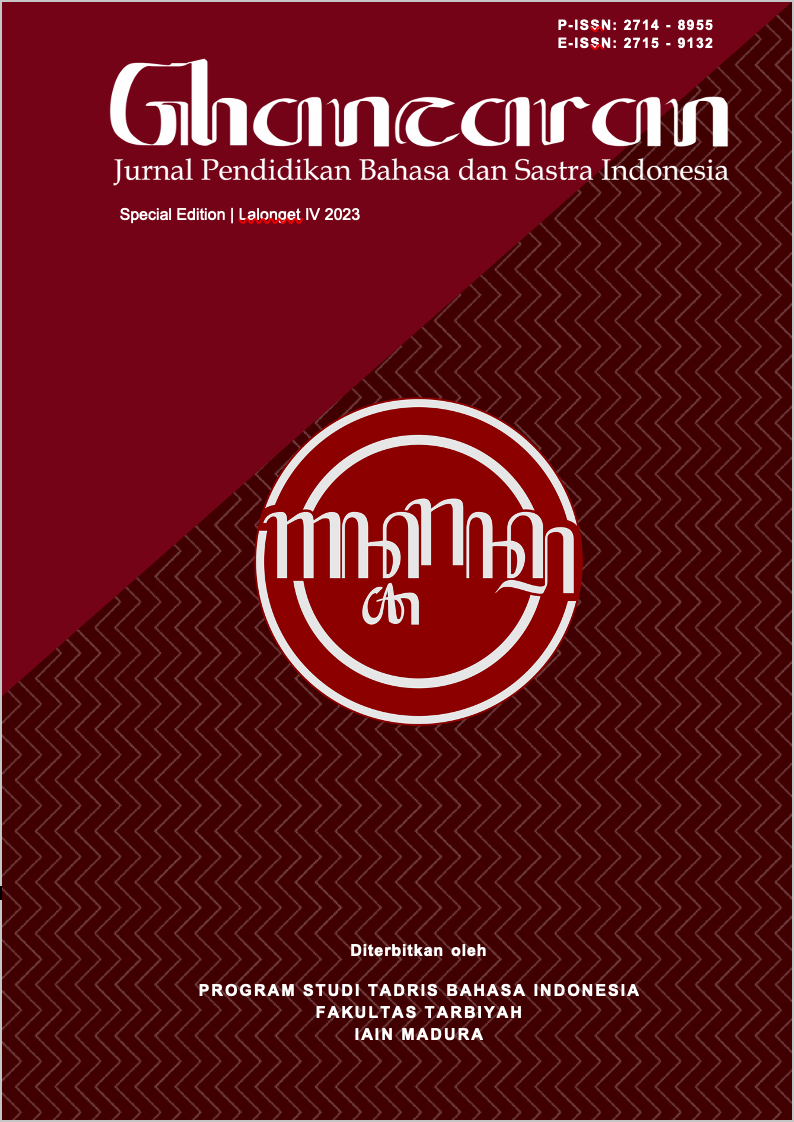Keefektifan Pembelajaran Mengidentifikasi Isi Cerita Hikayat Menggunakan Media Animasi pada Siswa Kelas X SMA
 Abstract views: 165
,
Abstract views: 165
,
 PDF downloads: 164
PDF downloads: 164
Abstract
Literature learning, especially the listening element, often receives little attention. One of the contributing factors is the teacher's lack of ability to present interesting learning material, which has an impact on reducing students' interest and motivation to learn in teaching and learning activities in the classroom. Literature learning, especially the listening element, needs to present interesting learning media. One of the media that can be used in literature learning, especially the listening element, is animation media. The aim of this research is to determine the level of effectiveness of using animation media in learning literary elements of listening, especially in learning to identify the content of saga stories. Researchers use methodspre-experimental by using designone group pre-test post-test in conducting research. The research results show that learning to identify the content of saga stories using animation media meets the criteria for effectiveness. This is measured based on the results of the t test which shows a significance value of 0.000<0.05, which means H0 rejected and Ha accepted. Animation media that presents visualizations in the form of moving images accompanied by sound can increase students' focus in listening to saga stories.
Downloads
References
Ariyana, Purawinangun, I. A., & Rojudin, R. (2022). Evaluasi Pembelajaran Sastra sebagai Alternatif Peningkatan Belajar di Sekolah. Jurnal Membaca Bahasa dan Sastra Indonesia, 7(1), 23–30.
Cahyani, N. M. D., Dewantara, I. P. M., & Wirahyuni, K. (2022). Pemanfaatan Media Video Animasi dalam Pembelajaran Menulis Teks Eksplanasi pada Siswa Kelas VIII SMP Negeri 2 Melaya. Jurnal Pendidikan Bahasa dan Sastra Indonesia Undiksha, 12(4), 417– 426.
Dewanta, A. (2020). Pemanfaatan Aplikasi Tik-Tok sebagai Media Pembelajaran Bahasa Indonesia. Jurnal Pendidikan dan Pembelajaran Bahasa, 9(2), 79–85.
Indriana, D. (2011). Ragam Alat Bantu Media Pengajaran. Yogyakarta: DIVA Press.
Kristanto, A. (2016). Media Pembelajaran. Surabaya: Penerbit Bintang.
Ningsi, N. P. S. (2018). Kemampuan Menulis Karangan Narasi Melalui Media Animasi Siswa Kelas VIII SMP Negeri 07 Palopo. Jurnal Onoma: Pendidikan, Bahasa dan Sastra, 3(1), 44–56.
Nurdyansyah. (2019). Media Pembelajaran Inovatif. Sidoarjo: Umsida Press.
Nuryadi, & Khuzaini, N. (2016). Keefektifan Team Game Tournament Ditinjau dari Kemampuan Komunikasi dan Pemecahan Masalah (Studi Eksperimen pada Siswa Kelas VIII SMP Negeri 1 Seyegan). Mercumatika , 1(1), 627–639.
Payadnya, & Jayantika. (2018). Panduan Penelitian Eksperimen Beserta Analisis Statistik dengan SPSS. Yogyakarta: Deepublish.
Pebriyanti, D., Sahidu, H., & Sutrio, S. (2017). Efektivitas Model Pembelajaran Perubahan Konseptual untuk Mengatasi Miskonsepsi Fisika pada Siswa Kelas X Sman 1 Praya Barat Tahun Pelajaran 2012/2013. Jurnal Pendidikan Fisika dan Teknologi, 1(2), 92–96.
Pranata, K., Kartika, Y. W., & Zulherman, Z. (2021). Efektivitas Penggunaan Media Film Animasi terhadap Peningkatan Keterampilan Menulis Cerita. Jurnal Basicedu, 5(3), 1271–1276.
Sugiarto, E. (2015). Mengenal Sastra Lama. Yogyakarta: Penerbit Andi.
Sugiyono. (2017). Metode Penelitian Kuantitatif, Kualitatif, dan R&D. Bandung: Alfabeta.
Windhiarty, W., Jafar, H., & Sulistyowati, E. D. (2017). Efektivitas Pembelajaran Menulis Teks Eksplanasi dengan Media Berbasis Adobe Flash Siswa Kelas XI SMA. Jurnal Ilmu Budaya, 1(4), 367–376.
Yusuf, M. (2017). Metode Penelitian Kuantitatif, Kualitatif & Penelitian Gabungan. Jakarta: Kencana.
Copyright (c) 2023 GHANCARAN: Jurnal Pendidikan Bahasa dan Sastra Indonesia

This work is licensed under a Creative Commons Attribution-ShareAlike 4.0 International License.
Ghancaran: Jurnal Pendidikan Bahasa dan Sastra Indonesia uses an Open Access Policy under the Creative Commons Attribution-ShareAlike 4.0 International License. Authors publishing in this journal agree to the following terms:
- Ghancaran Journal holds the copyright and grants the journal rights for first publication with the work simultaneously licensed under a

The work is distributed under Creative Commons Attribution-ShareAlike 4.0 International License which allows others to share, copy, and redistribute the material in any media or format and adapt, remix, change, and develop the material even for commercial purposes, as long as it is stated credit and license derivative works under similar terms. - Authors may make additional contractual arrangements for non-exclusive distribution of the journal's published work version.
- Authors are permitted to post their work online (e.g., in institutional repositories or on their websites) before and during submission, as doing so may lead to productive exchange.



















